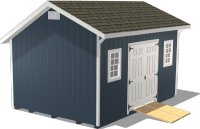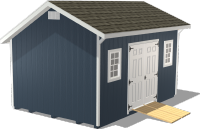How to Protect Your Shed — Use This Yearly Shed Maintenance Checklist
by Dakota Storage Buildings, on July 01, 2024

Sheds are essential structures for storing tools, equipment, and other outdoor essentials, but they require proper care and maintenance to ensure their longevity. However, many people are unaware of the appropriate maintenance procedures, leading to decreased shed value and a shorter lifespan. Neglecting shed maintenance can lead to premature deterioration. This blog will provide a comprehensive yearly maintenance checklist to help you protect your shed. From regular inspections to weatherproofing, shed organization, and security measures, this guide will ensure you know exactly what steps to take to keep your shed in top condition.Your
Step-by-Step Guide to a Perfectly Maintained Shed
1. Regularly Inspect and Repair Your Shed's Exterior
2. Organize Your Shed to Ensure Everything Is in the Right Place
3. Find and Fix Any Cracks, Breaks, and Holes
4. Effectively Seal Windows and Doors
5. Avoid Mold and Mildew With Proper Ventilation
6. Ensure Your Shed Remains Pest-Free
7. Check Handles, Doors, Shelving, and Workbenches
8. Keep Your Shed Looking New With Proper Washing
9. Implement Security Measures to Safeguard Your Valuables
How to Maintain and Organize for Durability
Maintaining your shed is essential to ensuring its longevity and safeguarding your investment. The good news is that it does not require much time or effort — just a little consistency. By following this yearly shed maintenance checklist, you will keep your shed in great shape, reduce the risk of costly storage shed repairs, and protect it from the elements, pests, and other potential threats. A well-maintained shed will not only serve its purpose more effectively but also retain its value over time.
Regularly Inspecting and Repairing Your Shed's Exterior
The exterior of your shed is the first line of defense against weather and other environmental factors, making regular inspection and any storage shed repairs a top priority. Begin by examining the walls and roof for signs of rot, which can weaken the structure over time.
|
Look for gaps or cracks in the siding, as these can allow moisture to seep in, leading to mold growth and structural damage. Repainting the exterior when necessary helps prevent weather-related wear and tear, especially in regions with harsh climates. |
|
The roof requires special attention. Missing or damaged shingles can lead to leaks, which can cause significant damage to the interior of your shed. Inspect the roof thoroughly, looking for any signs of wear or damage. If you find any issues, address them promptly to prevent further complications. |
By maintaining the exterior of your shed, you will ensure it remains durable and reliable.
Shed Organization for a Clean Interior
A clean and organized shed interior not only improves its functionality but also extends its lifespan. Start by decluttering — remove items you no longer need, and dispose of anything that is broken or beyond repair. Sweeping the floor regularly prevents dust and debris from accumulating, reducing the risk of slips or accidents. Shed organization keeps the interior clean and also discourages pests from making a home in your shed.
Organize your tools and equipment to create a tidy and efficient workspace. Consider installing shelving units, hooks, or storage racks to keep items off the floor. This protects your tools from damage and makes them easier to find when they are needed. Shed organization can boost your productivity and encourage you to use the space more effectively. Properly maintaining the interior can also help prevent future issues, such as rust or corrosion, which can occur if moisture is allowed to build up.
Proven Weatherproofing Strategies to Extend Your Shed's Lifespan
Weatherproofing your shed is a critical step in extending its lifespan and protecting it from weather-related damage. Sheds are constantly exposed to the elements, which means they are susceptible to rain, snow, wind, and extreme temperatures. Without proper weatherproofing, these elements can cause significant damage, leading to costly storage shed repairs and a shortened shed lifespan. By implementing a few key strategies, you can ensure your shed is well-protected and remains in good condition for years to come.
Finding and Fixing Cracks, Breaks, and Holes

Whether it is a missing shingle or a cracked window, it is important to fix problems as soon as they happen. If there are not obvious problems, proactively looks for potential issues in order to prevent them from starting or developing into an issue down the road.
Anything from bad weather to fallen tree branches can tear the felt or damage the roof. To prevent issues, check the roof of your shed on a regular basis. Even if your roof seems to be in working order, water can still sneak into your shed. To discover leaks, look out for discoloration on the ceiling and walls, particularly stains and darker patches which may indicate dripping or running water.
When you are giving your shed a once-over, do not confuse condensation with a leak. Condensation occurs when the moisture in the air forms water droplets on a cold surface. A properly ventilated shed is unlikely to have major problems with condensation but you can expect colder parts of the shed to attract condensation.
Bear in mind, that water can also penetrate a shed from the ground. If your shed sits directly on the ground, consider building a proper foundation for it using concrete, cinder blocks, or pressure-treated timber.
Whatever leaks, cracks, breaks, or holes you find, make sure to repair all of them as soon as possible.
In short, consider inspecting these specific areas:
- Windowpanes, sills, and seals
- Walls
- Roof
- Doors
- Floor
- Corners
- Foundation
Effectively Seal Windows and Doors

Windows and doors are common entry points for drafts and moisture, which can compromise your shed. To ensure your shed remains protected, focus on sealing these areas properly. Start by checking for gaps around windows and doors. Even small openings can allow cold air and moisture to seep in, leading to energy loss and potential damage.
Use high-quality caulk to seal any gaps around windows and doors. Apply a continuous bead of caulk to ensure a tight seal. Additionally, install weather stripping to prevent drafts and keep out moisture. Weather stripping is especially useful around doors, where there may be more movement. If any of the seals are damaged or worn, replace them to maintain an effective barrier against the elements. Properly sealed windows and doors also contribute to better energy efficiency and help maintain a comfortable temperature inside your shed.
Avoid Mold and Mildew With Proper Ventilation
Ventilation is often overlooked, but it is a crucial aspect of weatherproofing a shed. Without adequate ventilation, moisture can accumulate inside your shed, allowing mold and mildew to grow. Proper ventilation helps maintain a healthy environment and extends the life of your shed. If your shed has windows, ensure they can be opened to allow fresh air in and moisture out. Consider adding vents or installing a ventilation system if your shed lacks these features.
Ventilation is particularly important if you use your shed for activities that generate heat or moisture, such as woodworking, gardening, or storing plants. It helps prevent condensation from forming on the walls and ceiling, reducing the risk of water damage. Good ventilation also improves air circulation, making your shed a more comfortable and functional space. By addressing ventilation, you're taking a proactive step to ensure your shed remains weatherproof and free from moisture-related issues.
Tips to Ensure a Pest-Free Shed
Do pesky spiders, ants, pine beetles, wasps, and rodents like hanging around your shed? Perhaps they’ve made your shed their personal home. Not only can this be a nuisance to you, but it can also contribute to the deterioration of your shed and the items stored inside.
Keep your shed pest-free. Here’s how.
- Trim all grass and vegetation around the entire perimeter.
- Don’t stack firewood against the exterior of your shed.
- Don’t store your garbage cans inside your storage shed; it attracts many different insects (bugs love garbage!) and pesky squirrels.
- Keep all containers and bags tightly sealed—especially if they contain seeds, soil, or fertilizer. Once bugs get a scent of something, they will find a way inside.
- Sweep out or vacuum your shed once a quarter. Pests, like termites, prefer to settle in areas that seem untouched, so having a clean shed will help persuade them to stay out.
- Clean up and prevent standing water. Many bugs, especially mosquitoes, are attracted to puddles of water and will even lay eggs in them. Additionally, excess moisture can cause premature rot and decay in wood.
Just because you don’t have pest issues now doesn’t mean you’ll never have them. Think and act proactively.
Checking Handles, Doors, Shelving, and Workbenches

Difficult doors, squeaking hinges, and broken handles are annoying. Take a moment on a regular basis to spray hinges and handles with a lubricant like WD-40 to keep things moving and working smoothly. Replace broken handles with ones that work and won’t cause safety issues.
Take a good look at your shelves. Are they holding up ok? Are they still sufficiently sturdy? If they’re rusting (make sure it’s not because you have a leak in your shed!), consider replacing them with heavy-duty plastic or wood shelves.
How about your workbench — have you used it recently? If not, is there anything you need to do in order for it to be ready for use? If you notice low-grade wear and tear, now is a good time to take action.
Keep Your Shed Looking New With Proper Washing
Maintaining a clean exterior is a fundamental part of ensuring your shed's longevity. The exterior of your shed is constantly exposed to various environmental elements — dirt, pollen, bird droppings, and even mold and mildew — that can degrade the siding over time. To prevent this, regular washing is key. Start by assessing your shed's siding material, whether it is metal, wood, or vinyl, to determine the best cleaning method. A simple mixture of soap and water, along with a soft brush or sponge, is usually enough to remove most dirt and grime. For a deeper clean, a power washer can be used, but ensure it is set to a low-pressure setting to avoid damaging the surface. This manual cleaning method allows you to control the pressure applied, minimizing the risk of scratches or other damage.
For stubborn stains or mildew, a more potent cleaning solution might be required. A mixture of white vinegar and water (30% white vinegar/70% water) is a natural and effective way to break down tough stains and kill mildew spores without resorting to harsh chemicals. A solution of laundry detergent and water (1/3 cup of detergent to six gallons of water) can also work well. When cleaning, be careful around sensitive areas like windows, doors, and trim, applying less pressure to avoid damage. After washing, thoroughly rinse the shed with clean water to remove any leftover soap or cleaning solution to prevent residue buildup. Regular exterior cleaning not only keeps your shed looking good but also extends its lifespan by protecting it from the elements and preventing long-term damage.
Proven Security Measures to Safeguard Your Valuables

A shed can hold valuable tools, equipment, and other essentials, making it an attractive target for theft. To protect your belongings and ensure peace of mind, it is crucial to implement effective security measures. These strategies can also help reduce the risk of damage from accidents or extreme weather conditions. A secure shed not only protects your assets but also provides a sense of safety, allowing you to focus on other tasks without worry. Below are some essential tips for safeguarding your shed from theft and other risks.
Protect Your Shed With Quality Locks and Alarms
The first line of defense for your shed is a strong lock. Investing in high-quality padlocks is an excellent way to deter unauthorized access. Look for padlocks that are resistant to cutting or tampering, ideally with shrouded shackle designs for added security. You can also install heavy-duty hasps and hinges that are less prone to tampering or forced entry. Consider placing a second lock on the door or installing internal locking mechanisms for an extra layer of protection.
Security systems can significantly boost the safety of your shed. Motion sensor lights are a simple but effective way to increase visibility around your shed, deterring potential intruders who prefer to operate in the dark. These lights can be installed around the shed's perimeter or at key entry points to illuminate any suspicious activity. For even greater security, consider installing a security system with alarms. These systems can alert you to unauthorized access, and some even connect to your smartphone or a central monitoring service for real-time notifications.
Tips for Securing Valuables
Securing your shed does not stop at locks and alarms. Organizing and securing your belongings inside the shed is equally important. Use lockable storage containers for smaller items, which can be easily taken or tampered with if left out in the open. These containers can also protect against moisture and pests, preserving the condition of your tools and equipment. Additionally, anchor large items like workbenches, storage racks, or heavy machinery to the floor. This not only prevents theft but also reduces the risk of injury during storms or other disruptive events.
Organizing your shed in a way that makes it difficult for intruders to access valuable items can also enhance security. Keep frequently used tools and equipment in visible, easy-to-reach areas, while storing less frequently used items in lockable containers or behind barriers. This setup makes it harder for intruders to quickly grab valuables and leave, giving you more time to detect and respond to any security breaches. By implementing these security measures, you can ensure your shed remains a safe and secure space for your belongings.
Discover the Key to a Long-Lasting Shed
Proper shed maintenance is key to preserving the value and longevity of your shed. By following this yearly maintenance shed checklist, you can ensure your shed stays in top condition for years to come. From regular inspections and cleaning to weatherproofing and security measures, these steps will help you avoid costly storage shed repairs and keep your shed safe and secure. Get started on your backyard shed journey, by downloading our comprehensive “Shed Buying Workbook.” It contains valuable tips and insights to help you choose the right shed.

























